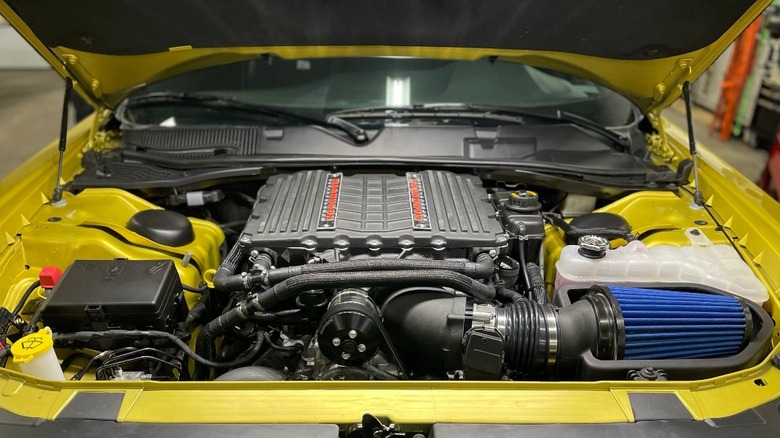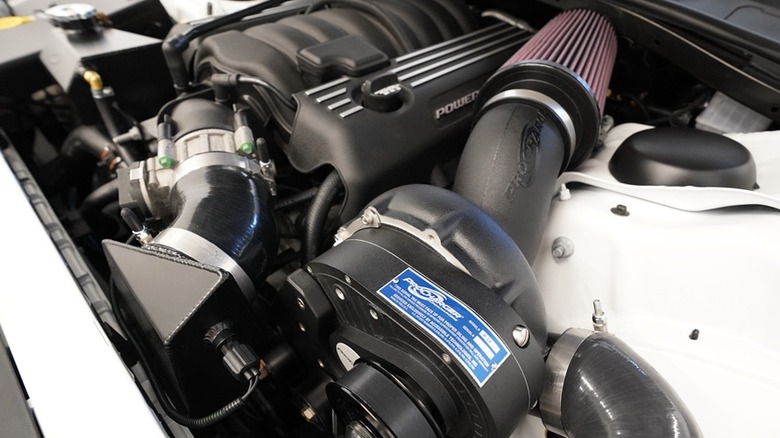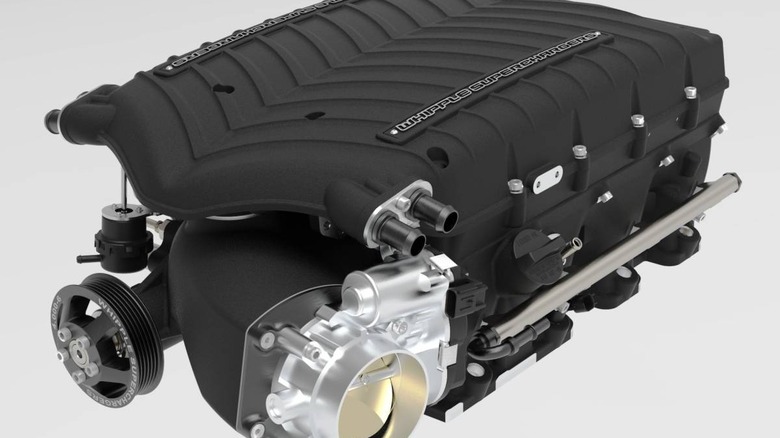How Much HP Does A Supercharger Add To A 6.4 HEMI? Here's What You Need To Know
Since the 6.4L HEMI was introduced in 2011, it has become a widely used performance engine in Chrysler's arsenal and has been featured in the Challenger SRT8, Charger SRT8, Chrysler 300C, Jeep Grand Cherokee SRT, and Dodge Durango SRT. Outside of its sporting applications, the 6.4L HEMI has also been found under the hood of work trucks like the Ram 2500 and 3500, in addition to some family haulers and SUVs including the Jeep Grand Wagoneer and Jeep Wrangler Unlimited Rubicon. Needless to say, the 6.4L HEMI is a versatile engine that produces a hefty amount of horsepower right from the factory.
While 470-485 horsepower and 465-475 lb-ft of torque in passenger cars and SUVs is plenty of horsepower for most people, there are always speed freaks out there looking for more. While the 6.4L HEMI responds well to naturally aspirated modifications – including camshaft, cylinder head, and intake manifold upgrades — another popular option is forced induction. Supercharger kits are extremely popular for the 6.4L HEMI and come in many varieties from centrifugal to roots to twin-screws.
The amount of horsepower that a supercharger can add to a 6.4L HEMI depends on a number of factors including the type of supercharger, other additional modifications, and the tune. Generally speaking, centrifugal superchargers can add around 200-215 horsepower to a stock 6.4L HEMI's output, while twin-screw superchargers can add upwards of 180 horsepower. Roots-style superchargers are often the least potent option, adding around 120 horsepower to a 6.4L HEMI.
How do the different types of superchargers work?
The type of supercharger plays a massive role in determining how much horsepower a blower can add. In general, there are three main types available for the 6.4L HEMI: centrifugal, Roots, and twin-screw superchargers. All three have benefits and shortcomings.
Centrifugal superchargers are similar to turbochargers in that they use an impeller to feed highly pressurized air into the engine. However, they are driven off the crankshaft to move the impeller. While centrifugal superchargers are more efficient than positive-displacement superchargers, their performance relies on engine rpm, limiting their full potential to the higher end of the rev range. Centrifugal superchargers can generally add the most horsepower to a 6.4L HEMI compared to positive-displacement options.
Positive-displacement superchargers can be split into two different types, including Roots-style and twin-screw superchargers. They both work in a similar way by using spinning rotors to compress air before forcing it through the intake manifold.
Roots-style superchargers move air between the spinning rotors and the supercharger housing before sending it through the intake manifold. Twin-screw superchargers compress incoming air between two differently shaped rotors spinning in opposite directions before the air enters the engine.
Unlike centrifugal superchargers, positive-displacement superchargers do not rely on engine speed, meaning that they provide the same amount of performance at all rpms. However, they are significantly less efficient and typically cannot provide as high of a horsepower boost as a centrifugal charger.
Other considerations for 6.4L HEMI superchargers
In many cases, a supercharger can provide more performance than a stock 6.4L HEMI can reliably handle. Most 6.4L HEMI supercharger kits are designed to be plug-and-play modifications, meaning that they come with everything that you need to get up and running, including some upgraded engine components. The 6.4L HEMI's factory fuel system is a limiting factor when it comes to supercharging, so a number of kit manufacturers include upgraded injectors, fuel rails, and fuel pump boosters. The included fuel system upgrades increase a supercharged HEMI's horsepower ceiling to a certain point, but after that, even more intensive upgrades are needed.
While the block of a 6.4L HEMI can withstand a hefty amount of abuse, with a capacity somewhere around 950 horsepower, its rotating assembly is notably weaker. The 6.4L HEMI's crankshaft, rods, and pistons can typically only withstand around 650 horsepower — if longevity is a priority — especially in boosted applications that put additional strain on the internal components. After the 650-horsepower mark, a forged crankshaft, forged pistons, and forged connecting rods are a good idea for engine safety.
Tuning is another important topic because it can dramatically impact how much power a 6.4L HEMI supercharger can make. Many prepackaged supercharger kits come with an included handheld tuner that uploads a set boost level and other parameters to the engine's powertrain-control module, limiting power to the supercharger's advertised specifications.
However, some manufacturers also offer "tuner" packages that include a supercharger package without a tune, leaving it up to you to install a custom tune. Tuner packages are the best option for 6.4L HEMI owners who already have mods installed or want to push the supercharger beyond what the standard kits can produce.


